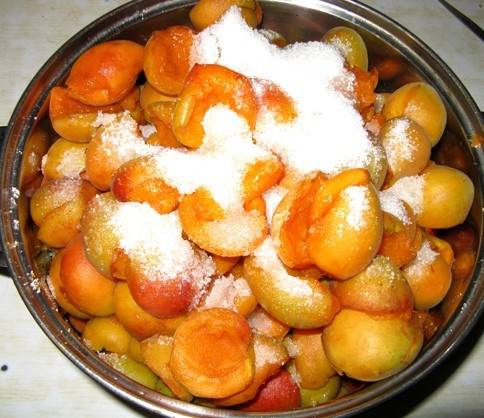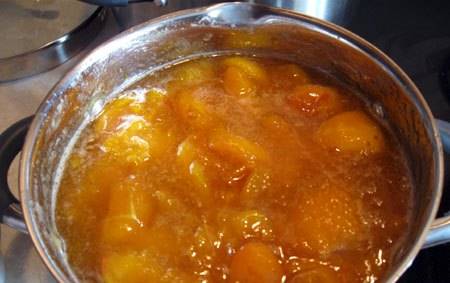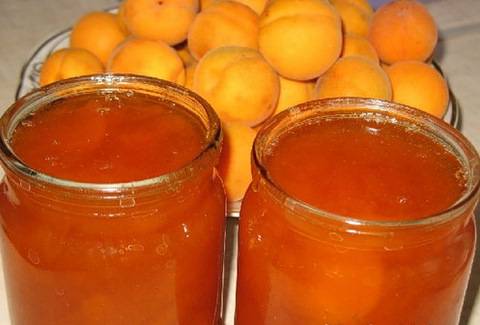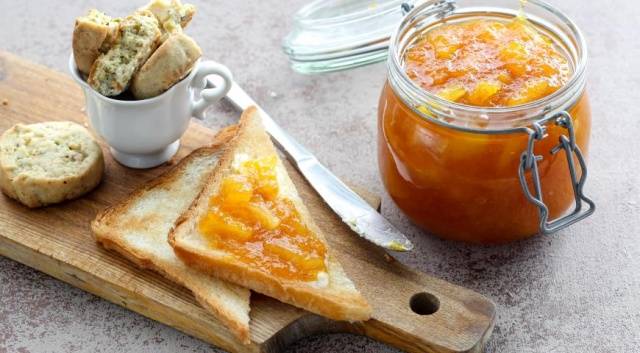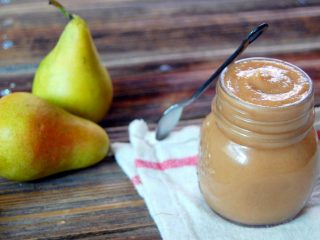Content
- 1 Preservation Tips
- 2 Recipes for pitted apricot jam
- 2.1 Thick jam recipe - classic version
- 2.2 Jam from apricot slices “Yantarnoe”
- 2.3 Pitless apricot jam “Pyatiminutka”
- 2.4 Recipe for apricot jam with kernels
- 2.5 Royal jam
- 2.6 Apricot jam with lemon
- 2.7 Apricot jam with orange
- 2.8 With gooseberries and bananas
- 2.9 With strawberry
- 2.10 With raspberries
- 2.11 With coconut
- 2.12 In a slow cooker
- 2.13 Sugarless
- 3 Green apricot jam
- 4 Dried apricot jam
- 5 Recipes for jam with seeds
- 6 Conclusion
Summer is a time not only for active recreation, but also for active production of all kinds of supplies for the winter, primarily in the form of delicious jam. And apricot jam, among others, is not at all in last place. Even those few who have never stood under a living apricot tree know and remember the taste of apricot jam. But you will be surprised when you find out what a variety of recipes for making it exist in the world. This article makes an attempt to display all the most delicious possible recipes for apricot jam, including those with a variety of additives.
Preservation Tips
To ensure that the jam is not only tasty, but also stored well, consider the following recommendations:
- For jam, you can take fruits of different sizes, but they must be healthy, dense and undamaged.
- It is best to cook jam in a copper basin, but in the absence of one, stainless steel dishes, preferably with a thick bottom, are also suitable. In enamel pans, jam often burns.
- Jars for storing jam must be washed well, preferably using soda rather than ordinary detergents, and sterilized in any way available to you (in boiling water, in the oven, in a convection oven, in the microwave) and dried. Jam should not be poured into wet jars., as moisture can cause mold and spoilage of the product.
- If you want the apricots or their slices to remain whole, then cook the jam in several stages with intervals. In this case, sugar gradually replaces water in the fruits and their pulp thickens.
- Mixing the jam should be very careful; it is better to shake the bowl periodically.
- The readiness of the jam can be determined by applying a thin stream of it to the plate - the stream should not be interrupted and spread on the plate.
- The jam will not be able to sugar if you add a small amount of lemon juice or citric acid to it at the end of cooking.
- When rolling the jam using tin lids, it is placed in the jars while hot.
- But traditionally, they wait until the jam cools down and only then put it in a container for storage - in this case, you can use nylon lids or parchment paper.
Recipes for pitted apricot jam
Of course, the recipes for making jam from apricots with pits removed have the greatest variety. This happens for various reasons:
- due to the traditional fear of being poisoned by certain substances that may be contained and accumulated in apricot kernels,
- due to the fact that apricot pieces are better soaked in syrup than whole fruits,
- finally, halves and even slices of apricots are ideally combined with various berries, fruits and other additives.
If someone still does not know how to make jam from pitted apricots, then from this chapter he will receive comprehensive information about the variety of ways to prepare such jam.
Thick jam recipe - classic version
This recipe is both the simplest and fastest in terms of overall preparation time. Although the result is classic apricot jam - thick and viscous, which can be spread on bread and used as a filling for pies.
This recipe does not use any additional ingredients other than apricots and sugar; even water is unnecessary.
Take 1 kg of pitted apricots and 1 kg of sugar. Prepare a wide bowl or pan and start laying out the apricots in layers, carefully sprinkling them with sugar. Everything on top should be completely covered with sugar. Leave the fruit to settle in this form in a cool place for 12 hours. It is convenient to do this in the evening so that they stand like this all night.
In the morning you will see that the apricots have given a large amount of juice. It's time to put them on heat and, stirring constantly, bring them to a boil. After the jam has boiled over high heat for about 5-10 minutes, reduce the heat and evaporate the apricot mixture for another 40-50 minutes, constantly stirring it and removing any foam that forms. The jam is considered ready if:
- Foam gradually stops forming;
- The syrup and the apricots themselves become transparent;
- If you place a drop of syrup on a saucer, it does not spread, but holds its shape.
Now the jam is cooled and, already cold, is laid out in sterile containers. You can close it either with nylon lids or with parchment paper, tightening it with an elastic band.
Jam from apricot slices “Yantarnoe”
This recipe is also considered a classic, but despite the fact that it takes quite a lot of time, the result is so amazing that it’s worth it. However, it doesn’t take much time to actually make it; rather, you need to be patient in order to withstand constant communication with a beautiful and tasty delicacy and not eat it.
2 kg of fully ripe, juicy apricots are washed in cold water, dried and cut into halves. The bones are removed and the halves are cut into slices suitable for your taste. In a large wide saucepan, apricot slices are sprinkled with sugar and left to soak for 10-12 hours.
After this time, the apricots filled with juice are placed on the fire and brought almost to a boil, but set aside again. After cooling completely, the apricots are carefully removed with a slotted spoon into a separate container, and the remaining syrup is again brought to a boil and cooked for about 5 minutes. After which the apricots are placed in it again, and the jam is again left to cool. A similar operation is performed as many times as possible, but not less than three. As a result, when the cooled syrup thickens so much that a drop of syrup placed between the index finger and thumb stretches into a strong thread, the apricots are no longer removed from the syrup.And the jam along with the fruits is brought to a boil for the last time and boiled for about 5 minutes. At this point, add half a teaspoon of citric acid or the juice of one lemon.
The jam is poured into the jars when it has completely cooled down.
Pitless apricot jam “Pyatiminutka”
In the modern world, where there is often not enough time even for the most necessary things, making jam has been somewhat modified. True, the name does not accurately reflect the cooking time - it will still take a little more than five minutes. Nevertheless, interest in jam - five-minute apricot jam - is increasing.
There are two main ways to make jam - five-minute jam from apricots.
1 way
For 1 kg of pitted apricots, take about 500 g of sugar. First, the syrup is prepared - literally 200 g of water is poured into the pan and all the sugar specified in the recipe is gradually dissolved in it over low heat. Then the syrup is brought to a boil and apricot halves are placed in it. The entire mixture is again brought to 100 degrees and boiled for exactly five minutes, albeit with continuous stirring over moderate heat. At the end, the resulting jam is placed in sterile jars and sealed with metal lids.
Method 2
This method allows you to better preserve the color, aroma and taste of apricots, and also helps to preserve large quantities of nutrients.Well-washed apricots are cut into halves, pitted, and sprinkled with the required amount of sugar. The container with apricots is set aside for 3-4 hours. After the juice appears in the apricots, the container with them is placed on the stove and the jam is brought almost to a boil with constant stirring so that the sugar does not burn. Immediately after the first bubbles appear, the jam is removed from the heat and set aside until it cools completely.
Then it is heated again to a boil and again set aside until it cools at room conditions. The third time the jam is boiled from the moment the foam appears for exactly five minutes.
When hot, five-minute apricot jam is placed in heated sterile jars, rolled up and stored in a cool place.
Recipe for apricot jam with kernels
It turns out to be very tasty to make apricot jam if you do not throw away the pits, but remove the kernels from them and mix them with the fruit while heating. The kernels give the jam a unique almond aroma and a slightly noticeable taste.
For 1 kg of fruit, take 1 kg of granulated sugar, 200 g of water and 150 g of apricot kernels.
Apricots are poured with boiling syrup, boiled for 2-3 minutes and left to soak overnight or 12 hours. The next day, the jam is brought to a boil again, the kernels are added to it and it is boiled until the fruits become transparent.
Royal jam
This recipe is so popular that it also has several varieties, both in production methods and in various additives. The main highlight of royal apricot jam (or royal, as it is sometimes called) is that apricot pit it is removed imperceptibly and replaced with some type of nut or with a kernel from the seed itself. As a result, the apricots appear intact, but with a delicious edible filling inside. Various additives are also useful, giving the royal jam a special noble aroma and taste.
But first things first. For royal jam, it is advisable to choose the largest and highest quality apricots - but they should not be overripe, but should retain density and elasticity. To remove the seed, you can make a small incision along the groove of the fruit. Or you can use a wooden stick or the handle of a wooden spoon, with which you carefully pierce each apricot through and through, thereby removing the pit.
To extract the contents from the seeds, you can pour boiling water over them for five minutes, and then they easily break into two parts, maintaining the shape of the nucleolus. Typically, apricot kernels have a sweet, almond-like flavor, but there are also varieties with bitter kernels, so be sure to test them before using.
Now kernels extracted from the seeds or almond nuts are inserted into the middle of each apricot.
At the next stage, the filling for the apricots is prepared. You need to mix 0.5 liters of water with 1 kg of sugar and 100 ml of dark rum, cognac or amaretto liqueur.The mixture is put on fire, brought to a boil and a cinnamon stick and two star anise are added to it. The syrup with all the additives is boiled for 5-7 minutes and then cooled. After cooling, pour it over the stuffed apricots and leave to soak for 12 hours.
The next day, the future royal jam is placed on a very low heat, covered with a lid and brought to a boil.
As soon as the jam boils, remove it from the heat and set it to cool again for 12 hours. This process is repeated three times. On the third day, the jam is brought to a boil for the last time, a cinnamon stick and star anise are removed from it and it is poured hot into jars.
Apricot jam with lemon
Lemon gives apricot jam some sourness, and it is very good to add a little cognac to this jam to obtain a refined aroma.
For 1 kg of apricots, as usual, take 1 kg of sugar, as well as 2 lemons, completely grated with the peel (but without seeds) and 100 ml of cognac.
Apricots are covered with sugar, grated lemons and cognac are added immediately. In this form, they are kept for 12 hours, after which they are put on heat and cooked either immediately until ready (the syrup is transparent), or at intervals of three batches, each time bringing to a boil, boiling the fruit for 5 minutes and cooling them.
Apricot jam with orange
Oranges form a very good combination with apricots and are used whole with the peel. You just need to extract the seeds after you have grated the whole orange, as they can add bitterness to the jam.
The rest of the cooking process is simple. 1 kg of pitted apricots is filled with 1 kg of sugar and infused overnight.Then the jam is brought to a boil and at this moment the orange mass from one large orange, grated through a grater, is added to it. The jam is boiled over medium heat for 15-20 minutes, then cooled and put back on the fire. This time it is boiled until the fruit is transparent, with constant stirring.
With gooseberries and bananas
This version of jam will surprise anyone with its unusualness, although the sourish gooseberry is surprisingly suitable for sweet apricots and bananas.
You need to prepare:
- 1 kg of apricots;
- 3 kg gooseberries;
- 2-3 pieces of bananas;
- 2.5 kg of sugar.
Apricots need to be washed, pitted and cut into large cubes.
The gooseberries are freed from tails and twigs, and most of them are ground using a blender or mixer. Approximately 0.5 kg of berries can be left for beauty.
Bananas are peeled and also cut into cubes.
All fruits and berries are placed in a pan, covered with sugar and the pan is placed on low heat. After boiling, the fruit mixture is boiled for 15 minutes and cooled. The foam must be removed. The jam should stand for about 12 hours in a cold place. After which it is reheated and cooked again, stirring, for about 15-20 minutes. The jam is placed in sterile jars while hot, but it is better to store it in a cool place.
With strawberry
Strawberries belong to the berries with dense but tender pulp, so they will combine perfectly with each other in jam.
Naturally, berries and fruits must be thoroughly washed and cleared of all excess - strawberries from twigs, apricots from seeds. It is better to cut the apricots into quarters, so they will better fit the size of the strawberries.
For such a combined jam, it is best to take 1 kg of strawberries and apricots. In this case, about 1.6 -1.8 kg of sugar must be added. A good addition to the jam would be the zest grated from one lemon and a small bag of vanilla.
Strawberries and apricots are covered with sugar, left for several hours until the juice is released and heated to a boil. After boiling for 5 minutes, the jam is removed from the heat and left to infuse for 3-4 hours. Then vanillin and lemon zest are added to it, everything is mixed and boiled again for about 10 minutes. After which the jam is removed from the heat again and left overnight. In the morning, the jam is finally boiled for another 4-5 minutes and, while hot, is packaged in jars and rolled up.
With raspberries
You can make apricot and raspberry jam using almost the same method. Only the proportions of the ingredients are slightly different - for 1 kg of raspberries, take 0.5 kg of pitted apricots, and, accordingly, 1.5 kg of sugar. In addition, for a better combination with raspberries, it is recommended to cut apricots into smaller pieces.
The resulting cooled jam will look more like confiture, since both raspberries and apricots contain a significant amount of a natural thickener - pectin.
With coconut
Another recipe for a very original apricot jam with a unique aroma and taste. In addition, it is prepared quite simply and quickly.
Prepare:
- 1.5 kg apricots;
- 200 ml water;
- 0.5 kg sugar;
- Half a lemon or half a teaspoon of citric acid;
- A vanilla bean or half a teaspoon of vanilla sugar;
- 4 tablespoons fresh or dry coconut;
- 1 teaspoon curry powder.
After pitting, cut the apricots into small slices.Boil syrup from water, sugar, vanillin, lemon juice and pour it over the apricots. Over very low heat, bring the jam to a boil and, stirring constantly, boil for 5-7 minutes. Add coconut and curry seasoning to the apricots, bring to a full boil again and place hot in glass jars.
In a slow cooker
A slow cooker can make life much easier for housewives, since it can prepare full-fledged apricot jam in just a couple of hours. For 1 kg of apricots, take 0.5 kg of sugar and the juice of one lemon.
Place pitted apricots, cut into halves, into a multicooker bowl, pour in lemon juice and cover with sugar. Then let the fruit brew and release the juice with the lid open. After the juice appears in the apricots, set the time to 1 hour, close the lid and set the multicooker to work in the “Stew” mode. As a result, you get jam with a fairly liquid consistency. You can already put it in jars and roll it up.
Sugarless
Making apricot jam without sugar is not at all difficult, but this dessert will be useful for people who, for health reasons, cannot afford to consume sugar.
1 kg of ripe sweet apricots are pitted, filled with a glass of water and placed in a saucepan over low heat. Boil the fruit for at least 20 minutes until softened. Then they are laid out in sterile jars, filled with hot juice and twisted. You can heat the apricots just until they boil and release the juice, and then put them in jars and sterilize for 10-15 minutes.
With stevia
If consuming sugar is contraindicated, but you want to try real sweet apricot jam, then you can use a plant-based sugar substitute - stevia leaves.
For 1 kg of apricots, take half a glass of stevia leaves or a similar amount of the drug from it and 200 ml of water. The rest of the manufacturing process is similar to those described above. A syrup is made from stevia with water, which is poured into halves of apricots, and infused with boiling three times.
Green apricot jam
In recent years, it has become fashionable to prepare preparations from unripe fruits and vegetables. For those who like such experiments, the following recipe is offered.
To make jam from 1 kg of green apricots, you will also need 1 kg of sugar, half a lemon, a bag of vanilla sugar and 2.5 glasses of water.
Unripe apricots have not yet had time to completely form a stone, so in order to properly soak the fruits in syrup, they must be pierced through with an awl or a long needle in several places. Then they need to be thoroughly blanched in a colander, dipped into boiling water several times and kept in it for one minute at a time. Then dry the apricots.
From the other ingredients in the recipe, cook the syrup and after boiling, add the apricots into it. Cook the jam for about an hour, stirring the contents constantly, until the syrup becomes both thick and clear.
Place while hot into sterile jars and close with screw caps.
Dried apricot jam
If you have a lot of dried apricots and you want to find the best use for them, then try making jam from them. It's not difficult at all.
For 500 g of dried apricots you need to take the same amount of sugar and 800 ml of water.Adding zest from one orange will improve the taste and aroma.
First, dried apricots should be rinsed well with cold water. Then they are filled with the amount of water according to the recipe and left for 5-6 hours. You need to boil the syrup in the water in which the dried apricots were soaked. While it is boiling, cut the soaked dried apricots into small pieces. Place dried apricot pieces into boiling syrup and cook for 10-15 minutes. At the same time, the top layer, the zest, is removed from the orange using a special grater, cut and added to the boiling jam.
It is necessary to boil for about 5 more minutes and the delicacy of dried apricots is ready.
Recipes for jam with seeds
Most often, apricot jam with pits refers to recipes in which the pits are carefully removed from the fruit and apricot kernels or other nuts are put in their place.
But you can also make jam from completely whole fruits, but it is recommended to eat it in the first season, otherwise toxic substances may accumulate in the seeds.
Traditional
Small apricots, such as zherdel or even wild apricots, are best suited for this recipe. Despite their small size, they are very sweet and aromatic. You will need 1200 g of apricots, 1.5 kg of sugar and 300 ml of water.
After washing, the apricots are pricked in several places with a wooden toothpick. At the same time, a syrup is prepared, which, after boiling, is poured over the prepared apricots. In this form they are infused for at least 12 hours, then brought to a boil and again placed in a cool place. The third time, the jam is cooked until it is ready, which is determined by the transparency of the syrup. This may take 40 to 60 minutes.During the cooking process, it is recommended to sometimes shake the jam along with the fruits. The finished jam is poured into jars when it has cooled down.
With cherry
In a similar way, jam is prepared from whole apricots with whole cherries. If you are not too lazy to let the jam sit for several hours between boilings and do this at least 5-6 times, then as a result you will get a delicious jam with fruit that has almost completely retained its shape. In this case, the last boiling should not last more than 10 minutes.
Conclusion
Apricot jam can be cooked in a variety of ways and everyone can choose a recipe to their taste.



